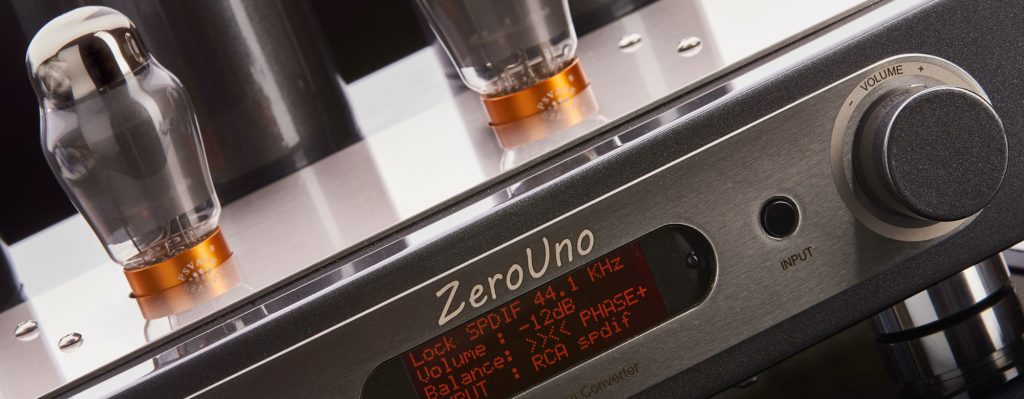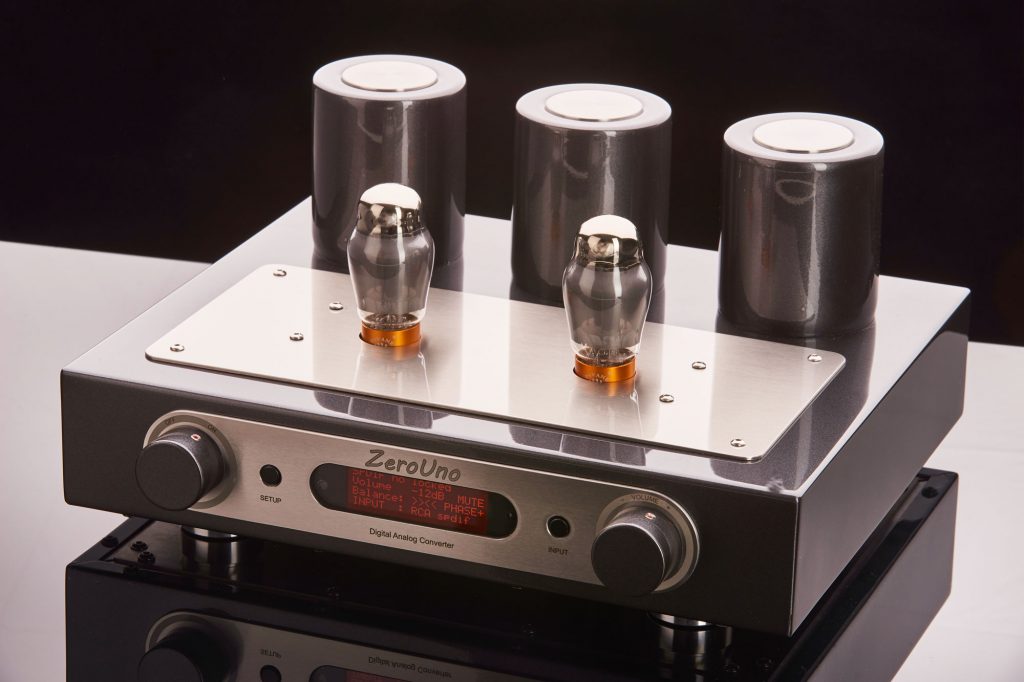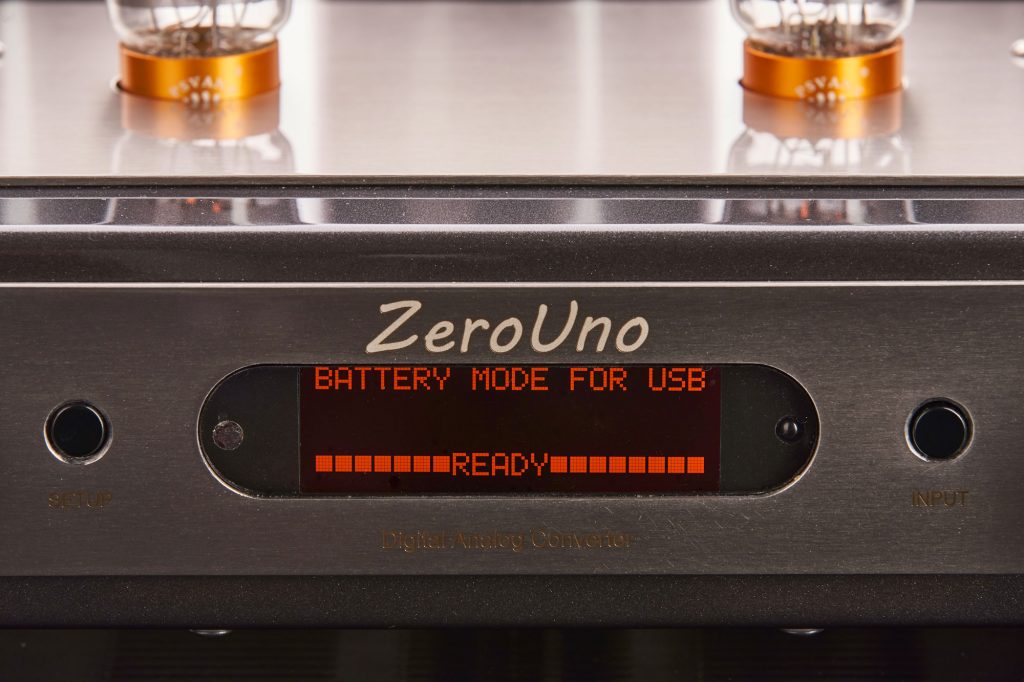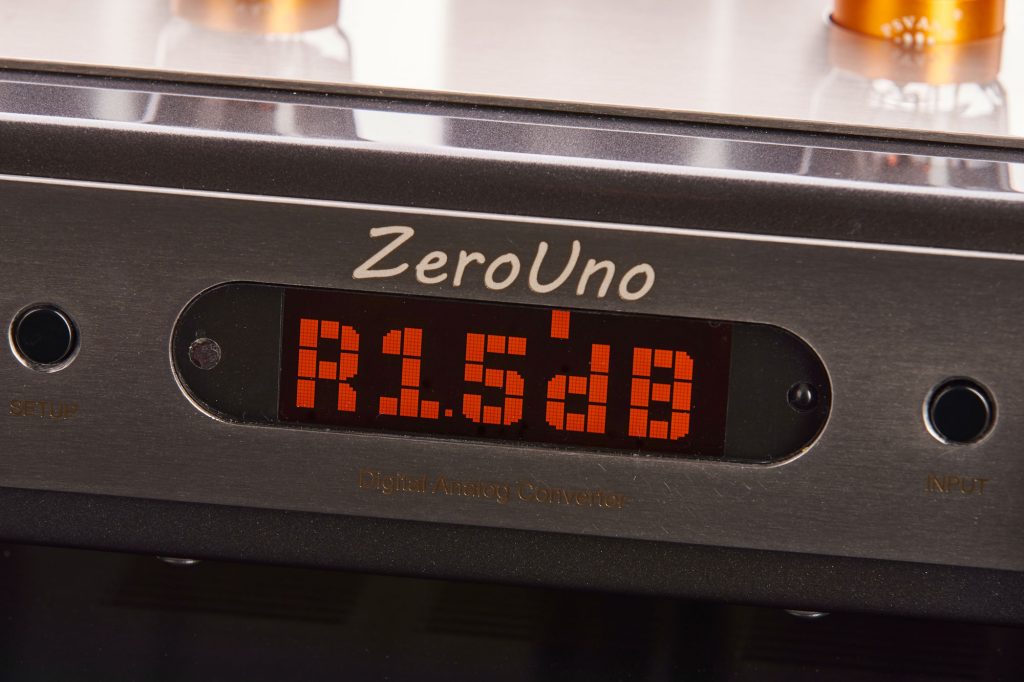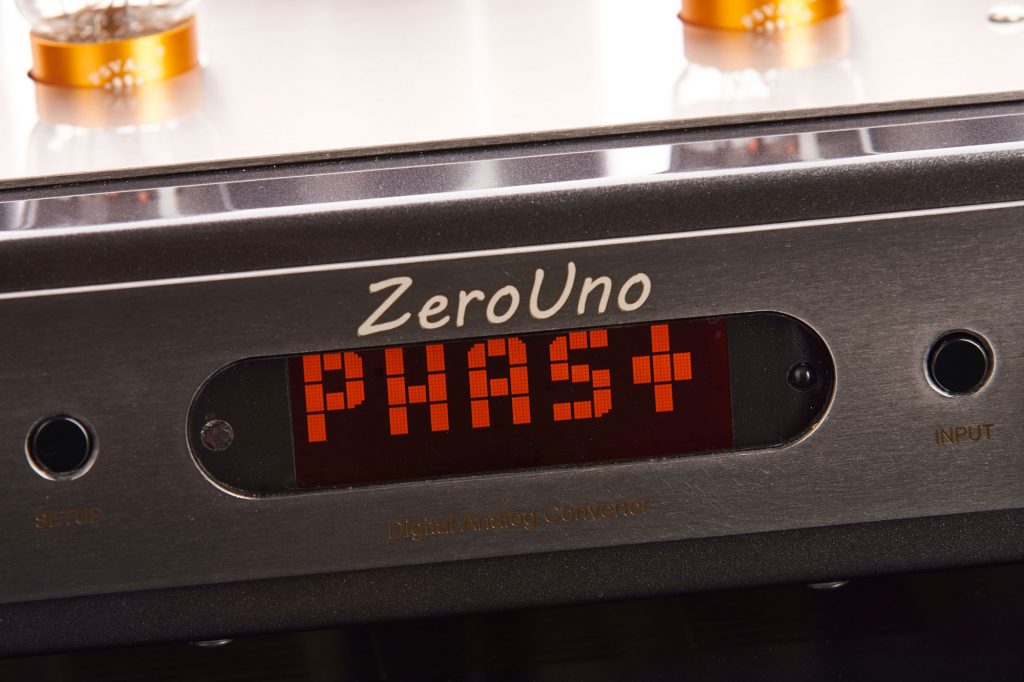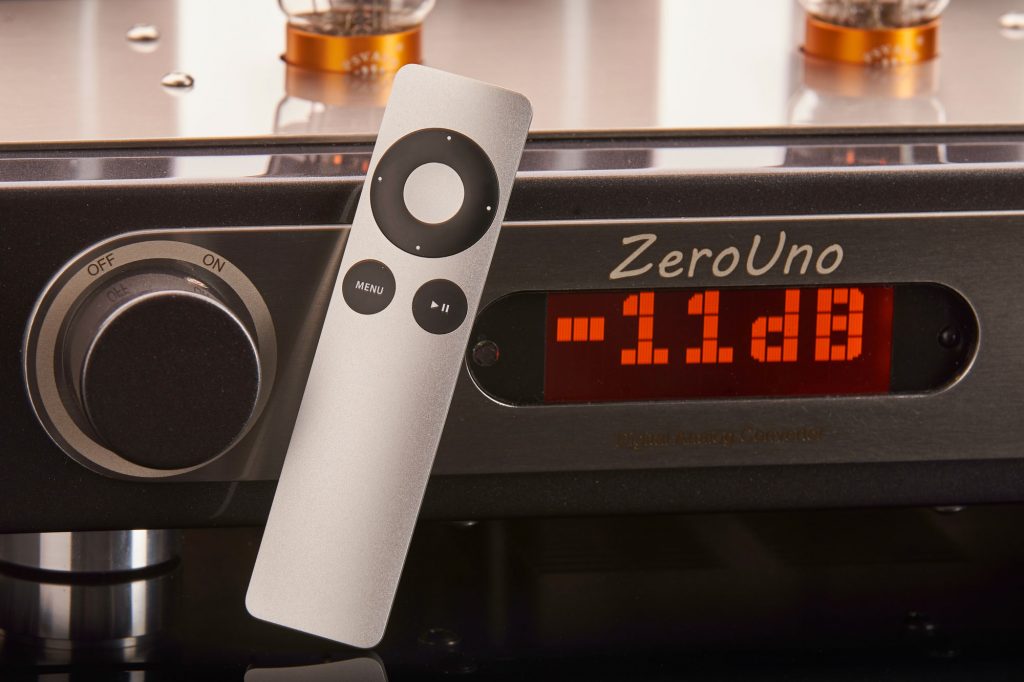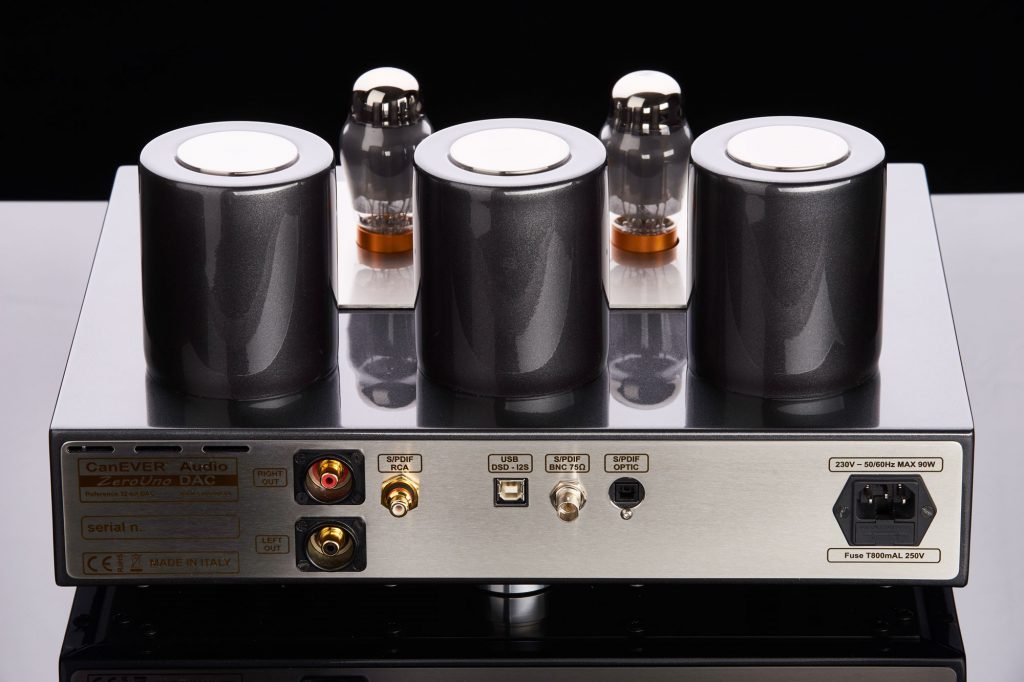CanEVER Audio Zero Uno DAC Tube DAC Extraordinare
Listed · 538 Views
1 Watcher
Items from this seller
This listing has ended.
Listings Similar to CanEVER Audio
Time Left: None
This listing has ended.
| Condition | NEW |
| Payment methods | Contact seller |
Contact seller after sale to pay viaVISA/Mastercard, American Express, Discover, Certified check, Personal check or Wire Transfer | |
| Ships from | Taos, NM, 87571 |
| Ships to | United States |
| Package dimensions | unspecified |
| Shipping carrier | unspecified |
| Shipping cost | Free |
| Original accessories | Remote Control, Box, Manual |
| Research Pricing |
If you would like to get the lushness of the best analog sound from your Digital Source the Zero Uno DAC from CanEVER Audio is just the ticket plus you can use it as a Preamp too for your Music Server or Transport. You don't have to take my word for it check out the review from Positive Feedback:
ZeroUno DAC Review – Part 1
05-04-2016 | By Roland Dietl | Issue 85In early February I picked up a large wooden box in the office of HiFi Statement. With the active support of Dirk Sommer, we both lifted the crate into the trunk of my car. After arriving at home and unpacking everything carefully, it stood before me: The ZeroUno DAC, which actually looks like a small tube amplifier. The ZeroUno is the product debut of the Italian audio manufactory CanEVER Audio.
The ZeroUno DAC, looking like a tube amp!
Admittedly, when I first heard about the ZeroUno, I was somewhat skeptical. Today, as a new DAC is presented to the market almost daily, I hold a DAC as a debut of a company to be highly ambitious. To design a DAC is a highly complex matter. First, there is the digital to analog conversion in itself: Think only of the extremely complex, but (in detail) completely different approaches of Rob Watts in the Chord DAC or a Ted Smith in the PS Audio DirectStream DAC. Furthermore, there are also the analogue output stage, the power supply, and the digital inputs, as well as the USB input circuit. It is my firm belief that all these sections have a significant impact on the overall quality of sound.
The development of a high quality analogue output stage and the design of the digital part of a DAC are in principle two completely different engineering tasks. The analogue part of the circuit and, most of all, the power supply in a DAC do not get the necessary respect from most of the today‘s electronic designers, from my view. Looking inside the cabinet of one or another DAC, I find myself thinking at how good that DAC would actually sound, if only it would be based upon a reasonably designed analogue circuit and/or power supply.
The ZeroUno DAC's display right after switching on the unit.
The design of a DAC with a high-end claim is therefore a big challenge in general, but especially for a small company such as CanEVER Audio. However, Mario Canever, the developer of the ZeroUno, is a full professional in digital as well as analogue electronics. A few weeks ago, I had the opportunity to talk with Mario Canever for an entire afternoon about the design of the ZeroUno. This DAC is "bursting" with a wide range of intelligent, highly interesting solutions. It takes care of the smallest details in signal processing, most of them way off the mainstream in engineering approaches, which are by no means any kind of "weird" solutions! Moreover, they are technically well thought-out implementations, which reflect the great experience of Mario Canever in the area of tube electronics as well as in digital technology.
To describe all the technical aspects of the ZeroUno is beyond the scope of this report. Therefore I decided to summarize my conversation with Mario Canever in a separate article (part 2 of this review), which will cover certain technical highlights of this DAC in much more detail. As I see it, the ZeroUno has really a lot to offer, and I would like to give our readers the opportunity "to look behind the scenes."
Even at this early stage of the review, I have to say that I hardly know of any DAC designed so consistently in such a number of different engineering aspects. The ZeroUno is a truly professional and high-quality manufactured product with a rock-solid housing, encapsulated power transformers and a number of top-quality, partly audiophile components mounted at the printed circuit board level. This is not to forget the finish and the painting quality of the cabinet, which is of first-class quality too.
The display of the ZeroUno DAC showing the "Balance" control at plus 1.5 dB for the right channel.
The front of the ZeroUno has a symmetrical look. A large and easy to read display dominates the center of the front plate. The display provides information about the selected digital input, the sample rate of the currently received signal, volume in decibels, balance, and absolute phase. The display's brightness is adjustable in several steps, according to personal taste. The left knob serves as an on/off switch, and with the rotary knob on the right, it is possible to adjust the volume. The volume control works in the digital domain with a resolution of 32 bits. With the small pushbutton located on the right of the display, the customer gets access to the various digital inputs. Using the pushbutton on the left side of the display, you get into the setup menu. Here, the balance is adjustable in steps of 0.5db and the absolute phase of the signal is selectable (0 degrees/180 degrees). It is possible to switch ON and OFF oversampling and to select jitter filters as well as filter types for PCM and DSD. Changing the resolution of the sigma delta converters between six and nine Bit is also possible.
My recommendation is to rely, with the exception of balance and phase, on the factory settings, and not fiddle with the others. To be safe, if you press the SET UP button for longer than 10 seconds, the factory defaults will be restored at any time. I am normally not a big fan of nested levels in a setup menu. The ZeroUno offers "only" one level. Use the SETUP button first for selecting the desired option, and then select the respective values by turning the rotary control knob at the right side. The DAC then saves the selected value automatically after 10 seconds. When in doubt, a well-crafted user guide provides assistance. The ZeroUno DAC comes standard with a stylish, comfortable, small, and lightweight remote control. This can operate most of the functions of the DAC, such as volume, balance, phase, and mute. This is all, what one actually needs to listen to music. Nice idea, I think, and a refreshing approach compared to the remotes of other audio components, which are often overloaded with too many buttons. If necessary, the user can get into the SETUP menu as well using the MENU button on the remote control.
The display of the ZeroUno DAC showing the phase in absolute polarity (+).
At the far right at the backside of the cabinet there is the IEC socket for the power cord. Then from right to left there are four digital inputs for TOSLINK (S/PDIF), BNC (S/PDIF; 75Ω), USB, and RCA (S/PDIF). The S/PDIF inputs accept PCM data up to 24 bit/192 KHz and the TOSLINK input accepts PCM data up to 24-bit /96kHz. Using the USB connector, PCM data up to 32-bit/384kHz are processed, as well as DSD64 and DSD128 over the DoP protocol (DSD-over-PCM). The USB port is ready for "native" DSD64, DSD128 and DSD256; however, the publication of the required XMOS driver is still pending. When using a PC with a Windows operating system, it is mandatory to install the USB driver. Here the proud owner of a ZeroUno DAC gets very comfortable support by an exemplary well thought document named "Driver Installation for Windows". Using that installation guide, even novice users should succeed in this task. This document can serve a user in general during the installation process of drivers for any other DAC too.
Listening to the ZeroUno DAC
For the listening test, I connected the analogue outputs of the ZeroUno DAC to my OMTEC preamp. Using the USB input, the DAC was "fed" by my JPLAY dual PC Setup running Windows 10 with Minim Server as a media server and kazoo in the latest version as control app for my iPad. The USB connection worked very well, even at the often critical switching between files with different sampling rates or data formats. This is an indication for a very careful implementation of the USB drivers and the USB input module. Even the change from DXD files in PCM format with 352.8 KHz to DSD files in DSD128 format was a shift that the ZeroUno handled without any problem.
Zapping through your music database without taking care about the different file types is pure fun. "Fun" is also the correct description for the mood I was in during the last few weeks using the ZeroUno. Please keep in mind: Before you start listening, allow the ZeroUno a certain "break-in" period. During this phase, the sound changes successively. At the end of that period, the sound "locked" down right, the room opened wide, the resolution increased, and the tonal match was detailed in the high notes, with bass that was very controlled. That DACs - regardless of the price - can sound very different is not a new insight. There are differences in the spatial picture. Too strong an analytical presentation will often "split" the soundstage into pieces, while extreme resolution in the midrange and in the higher frequencies "kill" the emotions during the listening. DACs present the lower notes in a variety of "textures" as well.
The ZeroUno instead acts completely different! Anyone who has ever heard how an absolute top-of-the-line preamp can lift the performance of an audio-set to another level knows what I mean. Suddenly the sound dissolves completely from the speakers and fills the room. It is not the spatial depth alone, but the way the DAC reproduces the music masterfully around the speakers, while the speakers themselves virtually "disappear." The excellent recording of "El Baile De Luis Alonso" by Giminez with the National Orchestra of Spain, conducted by Rafael Frühbeck de Burgos (Music of Spain - Rafael Frühbeck de Burgos Conducts the National Orchestra of Spain - HDTT 24/192) is a doorway to enjoyment. The sound is extremely realistic: cinemascope or widescreen format. At any time of the listening session, the soundstage will never degrade in its entire timely coherence, and there is no loss of even very fine details.
The remote control for the ZeroUno.
This becomes obvious by playing "Simple Symphony, Op 4 - Boisterous Bourree" by Benjamin Britten as performed by the Trondheim Solistene. This track was recorded in a church (originally in DXD format, so taken with a sampling frequency of 352.8 KHz). I used a version in 24 bit/192 KHz (The Nordic Sound - 2L audiophile reference recordings). The ZeroUno presents the spatiality of the church and the stupendous interplay between the different instruments of the orchestra, with its impressive fine dynamics, in a brilliant way. Even the fine details of this recording, as the delicate pizzicato of the individual string sections or the light reverberation of the Church, remain always audible, without the playback falling apart. The unity of the recording is impressive.
Equally fascinating is the tonality of ZeroUno. While the presentation of that DAC is rather on the warm side, it does not produce a soft tube sound! This does absolutely no harm to the live atmosphere playing the all-time hit "Hotel California" by the Eagles (Eagles: Hell Freezes Over; XRCD). This is real fun! The recording is supported by a massive and crisp bass. In "Wonderland" by Nils Lofgren (Nils Lofgren: Acoustic Live) each touch of the guitar and the resulting sound is captured perfectly. Never before have I heard this track better reproduced as with the ZeroUno DAC. Voices are reproduced incredibly realistic, and are a delight. Fascinated, I listened to "Sunrise" by Norah Jones (Norah Jones: Feels Like Home; 96 kHz) too. The ZeroUno manages the playback of the voice particularly impressively. "Let the music flow," one of the wonderful songs by Allan Taylor from the album (All Is One; DSD64) appears to be made for for the ZeroUno. Simply lean back and let the guitar and the voice move your mind.
The backplane of the ZeroUno DAC.
You know it already: the ZeroUno excited me. A visually and sonically impressive DAC, way off the mainstream. I listened with great pleasure for many hours, and I was still relaxed even after long listening sessions. This DAC is pretty close to my personal taste regarding reproduction of music at home. Stay tuned for the second part of the review, in which I shall introduce the technology of the ZeroUno DAC in more detail.
STATEMENT
An impressive debut! The ZeroUno is an exceptional product in all respects. A listening test is strongly recommended and then: simply enjoy!
ZeroUno DAC
- Dimensions (W / H / D): 40 / 18.3 / 36cm
- Weight: 10.1kg
- Digital Inputs:
- SPDIF/RCA, SPDIF/75ohm BNC (optional: AES/EBU-XLR), SPDIF, USB
- Sampling Rates:
- PCM: 44.1 kHz, 48 kHz, 88.2 kHz, 96 kHz, 176.4 kHz, 192 kHz, 352.8 kHz, 384 kHz;
- DSD over PCM: 2.822 MHz, 3.072 MHz, 5.644 MHz, 6.144 MHz (ready for native DSD up to DSD256)
- Analog-Outputs: RCA/XLR (unbalanced)
Contact Neal at Sound Science for more information [email protected] 720 308 4000 We also make complete music servers that rip, store, stream, play and have the easiest user interface.
www.musicvaultcat.com
We are also full line Harbeth, Lyngdorf, Vivid, Magnan cables, Wire World, Silver Sonic, Ear, Ortofon, Merging Technologies and more. WWW.SOUNDSCIENCECAT.COM
No questions have been asked about this item.
Ask the seller a public question
You must log in to ask a question.
Return Policy
Return Window
Item can be returned within 14 days of receipt.
General Terms
Items must be returned in their original condition, with all included packing materials and no signs of use. Buyer assumes responsibility for all shipping return costs unless the item was not received as described.
Refunds
Buyer will receive a full refund in the original payment method less any shipping charges.
Special Conditions
Please call if you want to discuss my terms for returns.


